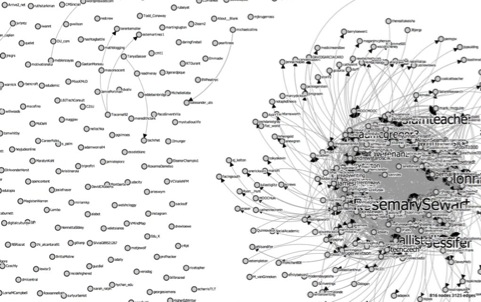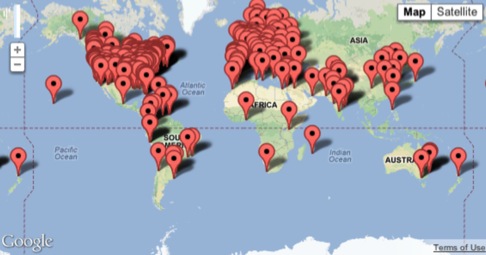“Building community doesn’t mean that learning happens.”
~ from an audience comment at InstructureCon 2013
Learning in a MOOC
Instruction does not equate to learning. This is the fundamental fly in the ointment of instructional design, and the epistemological failing of learning management systems and most MOOC platforms. Learning, unfortunately, is something no instruction has ever quite put its finger on, and something that no methodology or approach can guarantee. Instead, pedagogical praxis creates roads along which learning may take place (along with plenty of other experiences); and assessment is merely a system of checkpoints along the way to evaluate how well the road, the vehicle, and the driver are cooperating. In other words, assessment doesn’t measure learning. Assessment measures the design of the instruction.
According to old systems of instruction, massive open online courses are no different from other forms of online learning (which are no different from correspondence courses). They are click-to-read-the-next-lesson environments that guide readers/students down a specific path where information (in the guise of learning material) has been contained so that it may be mastered. Learning is meant to happen in coordinated steps, and as long as preconceived outcomes appear to be met, it’s a supposed win-win for students and teachers.
This, though, is like putting a lion in a cage and training it to jump through burning hoops: the lion tamer may master the beast in captivity, but this will not make him master of the African savannah. We haven’t learned anything new about online learning from MOOCs (especially Courserian and Udacian MOOCs) because we keep the lion in the cage. The kind of learning we need to have happen in MOOCs can’t be contained — not in neat and tidy discussion fora, video lectures, and standardized assessments. We must start by observing learning in its natural habitat with a hunter’s blind, good binoculars, and plenty of rations. MOOCs are anthropological opportunities, not instructional ones.
In the interests of exploring what MOOCs are and can be, Hybrid Pedagogy ran an experimental, sometimes tongue-in-cheek, mini- micro- meta-MOOC about MOOCs endearingly titled “MOOC MOOC”. This week-long course ran in August 2012 with over 600 registrants and again in January 2013 with over 1000 registrants. (A follow-up, 24-hour MOOC ran in June 2013 to explore the ways MOOC-inspired pedagogies can run amok outside massive online settings.)
MOOC MOOC explored unhesitatingly the potential, pitfalls, drawbacks, and advantages of massive, open approaches to teaching and learning. The course was designed to ask questions about the MOOC, to interrogate its makers and learners, and to ferret out how learning happens in a massive, networked environment. Most importantly, MOOC MOOC asked participants to explore MOOCs by participating in one.
Community as Learning
Learning is by its very nature meta-cognitive. Those who teach must, then, maintain a second-order perspective on their own craft. When we design, or begin thinking about designing, online or hybrid learning, we must not take anything for granted — including such instructional standards as the lecture, the discussion, the assignment, the assessment. We must remember that learning happens often without these things, and so adjust our thinking and design to make room for a more rampant sort of learning.
MOOC MOOC took the approach of a wildly open pedagogy, asking participants to provide their own content to a great extent, and offering only a skeletal structure for discussion and collaboration. The result was one in which the community of participants were inventive, creative, and intensely productive — perhaps exactly because they had to be. Essentially, we asked the participants themselves to invent the MOOC as they worked within it. In order for the MOOC to succeed, participants had to work together to create the content. (We’ve used Scoop.it to curate a small sample of the hundreds of videos, blog posts, and Storifys produced during or in response to the course.)
While critics of MOOCs hold that these massive courses cannot possibly be interactive, we discovered that an interactive community rose out of MOOC MOOC and formed the heart of the participants’ learning experiences. As analytics from MOOC MOOC demonstrate (see especially slide 10), interaction is not only possible within a MOOC; it also has the potential to be extremely dynamic.
While the course was set up as an investigation of a cultural and educational phenomenon, what it revealed was that learning can happen spontaneously and effectively when community is formed. Although some might argue community does not equate to learning, we claim just the opposite: community functions not as a methodological approach toward a set of outcomes but as the outcome in and of itself. As Dave Cormier says in “Community as Curriculum”:
In the rhizomatic model of learning, curriculum is not driven by predefined inputs from experts; it is constructed and negotiated in real time by the contributions of those engaged in the learning process. This community acts as the curriculum, spontaneously shaping, constructing, and reconstructing itself and the subject of its learning in the same way that the rhizome responds to changing environmental conditions.
We don’t need courses to scaffold content. Community is its own content — with its own requirements for learning and mastery — intrinsically not instrumentally rigorous. The action of interactivity is itself a learning experience.
Building Community in a MOOC
Participants in MOOC MOOC functioned almost like a hive mind. They had individual agency, but the course activities emphasized the capacities of learners working in concert. For example, one of the first activities had groups of 50 coauthoring and revising a single 1000-word essay. Participants also formed their own communities to discuss the nature of participation in MOOCs, and formed independent groups to brainstorm their own MOOCs. These activities were created by the designers of the course, and so any associated outcomes could be measured. But more important to our assessment is how a community formed around the activities, and how participation in that community allowed the various activities to be hacked.
The products of daily assignments, the artifacts created independent of those assignments, as well as participation in native fora are all measurable by traditional instructional metrics. We contend, though, that the richness of these products derived specifically from the dynamic collaboration and community that was the learning environment. However, what is even more interesting to examine is the less concrete proliferation of interaction, much of which went beneath our notice (because of its sheer quantity, spontaneity, and heterogeneity).
As educators, we’ve worked in networked environments to encourage a reconsideration of the divide between work we do in classrooms and work we do in the world. More and more, social media platforms — and Twitter in particular — have become the fulcrum around which this element of our pedagogies tilts. Twitter enables exactly our desire to facilitate improvisation within a framework. The 140-character limit of the Tweet invites a careful consideration of each utterance, often asking for a flurried dance of abridgements within its frame. And the loveliest aspect of Twitter is what gets built around those only seemingly constrained 140-character tweets: an ecosystem of interconnected, conversant, and ecstatic bits that break their own frame through links, photos, videos, mentions, replies, archives, favorites, and Storifys.
MOOC MOOC relied heavily on Twitter to build a diverse community of learners. Daily chats using the #moocmooc hashtag helped the community connect around ideas presented in the course. But more than that, Twitter served to make the course a continuous experience — across time zones, days, activities, discussions, etc. More than being the course we built inside the Canvas learning management system (which served as a portal not a reservoir), MOOC MOOC was the distributed community that rose up around it. If the community was the learning, then Twitter was where learning happened.
This data visualization from Martin Hawksey depicts over 6500 tweets from the #moocmooc hashtag, each node representing a single tweet linked to other tweets through @ replies and assembled into a diverse array of what Hawksey calls “conversation shapes.” Interactions range from a simple exchange to complex branching patterns of epiphany, response, interruption, and confluence. The varied connections and paths of each discussion illustrate that this is not a cacophony of disparate voices but a colorful and complex web of collaboration and dialogue. What this visualization depicts is learning — connections being made between people around ideas, questions, discoveries.
The participants in the first iteration of MOOC MOOC composed approximately 40 tweets per hour on the #moocmooc hashtag. Tweet volume increased over the course of the week, hitting a peak on Thursday (with 1,246 tweets that day). The above image, a screenshot from another interactive visualization by Martin Hawksey, offers a different view of the nearly 7,000 tweets from that first week in August 2012. This time the nodes depict people, the size of their names proportional to their level of participation. The course designers and facilitators loom large but are part and parcel with the rest, orchestrating the environment but equal players in the encounter. A whirling mass of participants in dynamic conversation with a halo of outliers, single remarks casually tossed into the din from lurkers or momentary passersby. Several concentric circles, each depicting a participant group that engaged the course in a particular way: fully immersed participants, more casual participants, and disconnected onlookers. The ball rolls across the screen almost appearing to gather up rogue tweeters in its wake. (We used Hawksey’s TAGSExplorer again to make a dynamic visualization of the tweets from the third iteration of MOOC MOOC. For full data from this 24-hour course, see http://bit.ly/MOOCathon.)
Data as Poetry
Something we discovered (and that other MOOC designers have discovered) is that the MOOC MOOC community persisted beyond the end of the course. Participants created personal learning networks based on their experiences and experiments within MOOC MOOC, and, using those communities, they carried their learning from the course out into the world. MOOC MOOC, then, affected learners who never even entered the course, by transmission from those who did.
This kind of learning can’t be scaffolded or too-carefully architectured but must be discovered in the act. In A New Culture of Learning: Cultivating the Imagination for a World of Constant Change, Douglas Thomas and John Seely Brown write, “Our understanding comes not through a linear progression, in which each step confirms that you are on the right path. Rather, it arises through approaching the problem from many angles and ultimately seeing its logic only at the end” (98).
So what does the data from MOOC MOOC tell us? Is it enough to take note of the significant participation by hundreds of people in the course? Or should we be looking at ways that particular conversations led to other particular conversations? When looking at the data assembled by Martin Hawksey, some will not see the qualitative value there. But this objection may come from an inability to read the data for what it represents. The data suggests that something is happening. What we need are new ways to read the data, analyzing its poetry where once it had only quantitative character. We need to close-read learning data to begin hypothesizing and ruminating on what it means, rather than jumping too quickly (and prematurely) into assessment. We should not ask learning to conform to the methods we have for measuring it; instead, when we wonder how (or whether) learning happens, we must begin not with “how do we measure this?” but with “what is really going on?”
If the course isn’t the content but is instead the community, then MOOC MOOC was not seven days long. In fact, the Canvas course only turned the key in the ignition… But the community that persists is the engine itself. When we build learning experiences that persist beyond our ability to make them go, our courses become permeable and live outside the institution in which they’re housed, beyond the term during which they’re taught, and even off the continent where they’re born. This is the kind of learning to which MOOCs (or any course) should aspire — not a poor mimicry of what we already do, but learning that’s informed by the peculiar potentials of people working in community.
[The over 1000 official registrants from the January 2013 MOOC MOOC.]
In his original announcement for MOOC MOOC, Jesse argues that “Content and learning are two separate things, often at odd… Most content is finite and contained; whereas, learning is chaotic and indeterminate. It’s relatively easy to create technological infrastructures to deliver content, harder to build relationships and learning communities to help mediate, inflect, and disrupt that content.” A course, then, is a container for people and not content — a gathering place, a laboratory, that is intensely and necessarily social. This is a kind of learning we don’t yet know how to adequately measure.
This article marks the relaunch of www.moocmooc.com, where we’ve now archived all the articles written for the three iterations of MOOC MOOC, along with artifacts from the course, a bibliography, Twitter-feeds, galleries, and more. As we turn our attention toward other experiments, we’re here putting the MOOC MOOC monster (at least temporarily) to bed.
[Photo by @Jessifer]





